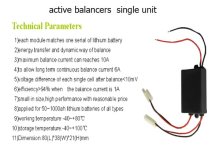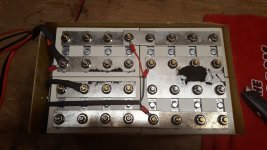"Any recommendations for the balance boards? I don't know where to start or even know what to look for, nor how to connect them. Do the balance boards work independently of the BMS? Also, I'd really like to be able to charge the battery at a high rate with a 20A LiFePO4 charger (I currently have a 10A charger). Given some of the above discussion about active balance etc, will I be able to use the 20A charger?
Thanks again for all your help."
The active balancers and the bleeder type balancers work independent of the BMS, you still need a BMS, I wouldnt run a battery which has balance issues without a BMS. The charger you have is a constant voltage, it won't monitor the balancing. Your battery could be 14.3 volts and 3 of your cells over there 3.65 volt limit severely out of balance and it will still be charging it, the BMS will protect against that.
The small 1.4 amp balance modules won't be able to keep up with your 10 amp charger, technically your charger will be putting out 2.5 amps to each cell(some more some less), the high cell will have to bleed off 2.5 amps. But if you use 2x 1.4 amp modules on each cell you can do it, it will be bleeding off 2.8 amps which is just a little more then you need.
The one I use on my lifepo4 is a 4s module, but they also sale single modules that you connect with other modules, those cost 26 dollars each.They can balance at 6 amps constant (10 amps peak) if you need to charge at 20 amps, you need active balancers. I tested mine at 15 amps charging current. At 6 amps constant they can handle (6 amps x 4s) = 24 amps charge current. You connect red wire to plus of each cell and black wire to neg of each cell, then the connectors are connected to each module on every cell.
The active balancers cost more but for a battery with balancing problems, it will keep it usable. Without the active balancers my battery would only be able to be charged with a balance charger, and with its balancing problems it would be an all day affair. Right now I have it connected all day to a solar panel / mppt controller which charges by overall voltage like your charger, its been like that for over 6 months, I don't need to monitor like before, worst case BMS will stop the charging but its been perfect.
This is a picture of the single balancer and its specs. Same company electriccarpartscompany sells them.




